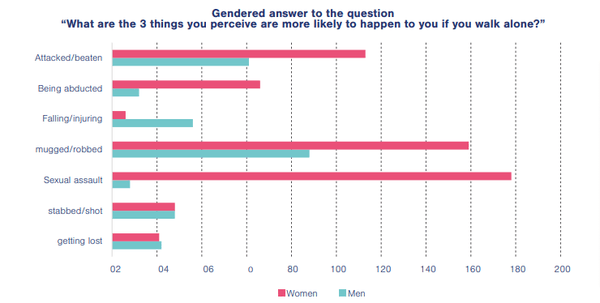Walking is one of the most common forms of exercise and there are a huge range of benefits to be enjoyed. If you’re familiar with 3DActive then you are probably aware we’re huge advocates of walking and are always encouraging our community to get out and walk more. Perhaps you're even a proud owner of our best-selling 3DFitBud Simple Step Counter to track your daily steps and to get you motivated to walk more.
With Summer just around the corner there will be many opportunities to get out and enjoy the summer sunshine and the beautiful outdoors. However, walking outdoors, particularly at night, can have its dangers and sadly assaults on joggers and walkers can be a common occurrence. In fact, fear of assault is a big reason many women don’t like walking. In a recent study conducted by two Columbia University researchers, people from 12 countries including the USA were asked how safe or unsafe they felt whilst walking in their communities. Shockingly around 30 percent of female participants would choose alternate modes of transport out of fear of assault and incredibly 70 percent of women said that sexual assault was their number one fear when walking.

This is an incredibly sad statistic and no one should ever be denied life’s simple pleasures out of fear of getting assaulted. We have put together 10 ways to help you keep safe on your walks so you’ll have the confidence to get out and enjoy the outdoors whether it be for pleasure or for improving your mental and physical health.
PLAN YOUR ROUTE AHEAD OF TIME
If you walk the same route daily then you will be very familiar with the journey and should be aware of any possible dangers. However, this can be quite dangerous because predictable patterns make it easier for potential stalkers or attackers to plan their next move. Plan out more than one route so you can mix things up and if you are planning on walking a new route, make sure you know the way so that you don’t get lost or stumble into any unknown areas. Not only is having multiple routes a safety measure but having variety will also keep things fresh and interesting. Choosing a route frequented by other joggers and walkers is also a great way to increase your safety and dissuade attackers from making you a target.
TELL SOMEONE WHERE YOU'RE GOING
It is always advisable to let a friend or family member know when you are going out for a walk and how long you're expected to be. Even if it is a short walk with the dogs on a well known route or to the shops, not only is it good for someone else to know where you are going in case something happens but it will also help you feel more reassured so you can enjoy your walk more.
CARRY A PERSONAL SAFETY ALARM
Carrying a non-violent deterrent such as a personal safety alarm is an underestimated yet extremely effective way to keep safe while you walk. A personal safety alarm is a small, lightweight electronic device that you can clip to your waist, around your neck or on your bag. When you’re feeling unsafe or threatened, simply pull the pin out and it will let off a loud alarm to alert others and draw attention to yourself. Some alarms also come with a flashlight which can help in attracting attention or reducing the attackers visibility by shining it in their eyes giving you more time to run to safety.
Please see our guide on how to use a personal alarm safely and effectively.
WALK WITH A FRIEND OR IN A GROUP
Safety in numbers is a term often used and one that rings true in so many situations. Walking with a friend or in a group is a sure way to be safer on your walks as it is very unlikely for a dangerous person to approach a group. Assaults on walkers are almost always when they are alone and in quiet or unlit areas.
Walking with a friend or in a group is also a great way to be sociable and to make the journey that much more enjoyable. If you’re new to an area then it is also an easy way to meet new people and make new friends.
KEEP THE VOLUME DOWN
Many of us enjoy listening to our favourite music whilst out on our walks and although this can make things more enjoyable, having the volume up too high is a definite no-no. If your music is too loud then there is no way to effectively monitor your surroundings and listen out for any dangers such as cars, bicycles or other people. Always keep the volume low enough so you can hear what is going on around you. If you tend to walk at night or in low-light situations then we strongly suggest ditching the headphones altogether as you can be particularly vulnerable during these times and clear hearing and no distractions is vital. Dangerous people are often opportunists and seeing a distracted person walking could be an opportunity to them.
BE VISIBLE
Always be sure to wear appropriate clothing and to be visible when you walk and avoid dark colors like black and navy blue. Particularly if you’re walking at night, then wearing bright colored or reflective clothing will make you more visible to people and traffic. It is also essential to wear the correct clothing during the day and it is recommended to check weather conditions before you set out on your walks so that you are suitably dressed. Wearing appropriate shoes is essential too, most branded trainers are equipped with reflective strips to help in low visibility and if you’re going on a hike be sure the wear footwear with sufficient ankle support.
KEEP YOUR PHONE ON YOU
Whilst walking with your phone can be a distraction as it is tempting to scroll through your social media or text while you walk, we do recommend keeping it on you as it will be needed if you run into any trouble on your way and you need to call for help. We also recommend you activate your location settings on your phone so that if you do find yourself in an emergency situation your phone can be used to accurately track where you are. There are also apps you can use so that friends or family members can follow your progress and see where you are at all times.
KEEP YOUR BELONGINGS DOWN TO A MINIMUM
Leave any non-essential belongings at home such as jewellery as these can call unwanted attention to yourself and are attractive to potential thieves. Only carry what you need to and keep any essential valuable items out of plain sight. Running Belts are very useful to keep your belongings safe and secure. They are lightweight so will not interfere with your walking and some even come with reflective strips to help keep you visible to traffic at night or in low-light situations.
TAKE A SELF-DEFENSE CLASS
Being able to physically defend yourself from a potential attacker is a skill set that everyone should have in some form or another. Sometimes even the most beginner moves can be enough to deter an attacker and get away. A fundamental part of most self-defense classes is learning how to identify potential threats and methods of avoiding any confrontations before they even occur. Be sure to check out this very insightful article to find out what could be the most suitable class to suit your own needs.
TRUST YOUR INSTINCT
If you’re out walking alone then trust your instincts! If ever you feel uneasy about a particular route, street or you think a situation can become dangerous then trust your instincts and use an alternative route. Always be vigilant and pay careful attention to where you are and what is going on around you. If you do feel like you’re being followed or you’re in a dangerous place then walk towards a well lit area with lots of people as quickly but naturally as possible. Once there, you can then phone a friend or get a taxi to take you home.
Follow these safety tips to give yourself the best chance of going out and enjoying yourself and the many benefits that walking has to offer. It is important to understand that not everything is in your control but these ten tips will certainly help minimize the risks when you’re out walking.




